When little and large meet, you get the HUG dog, or as I prefer, the PUGSKY!
One of the most surprising and popular husky mixes out there is the husky pug mix, and in the following guide we explain everything you need to know about this mischievous, yet adorable crossbreed.
Table of Contents
Snapshot of the Husky Pug Mix
| Attribute | Husky Pug Mix |
|---|---|
| Average Weight | 15-60 pounds |
| Average Height | 10-23 inches |
| Life Expectancy | 12-15 years |
| Price | $1200-$2500 |
| Color | Typically a mix of the Husky’s and Pug’s colors. Common colors include fawn, black, silver, and white. |
| Coat Type | Medium length, straight and double-coated. The coat is thicker than a Pug’s but not as dense as a Husky’s. |
| Temperament | Intelligent, energetic, sociable. Can be stubborn at times. |
| Exercise Needs | Moderate to high. They need at least 30-60 minutes of exercise daily. |
| Health Issues | May inherit issues from either breed, such as hip dysplasia, eye problems, and breathing difficulties. |
| Training Difficulty | Moderate. Early socialization and consistent, positive reinforcement methods work best. |
| Grooming Needs | Moderate to high. Regular brushing is required to manage shedding. |
| Good with Children and Other Pets | Generally, yes, but socialization from a young age is crucial. |
| Living Conditions | Adaptable to both apartments and houses, provided they get enough exercise. Not suitable for hot climates. |
Remember that individual traits can vary widely depending on which parent’s genes are more dominant in a particular dog. And with the two dogs being so different from one another, the results can change dramatically!
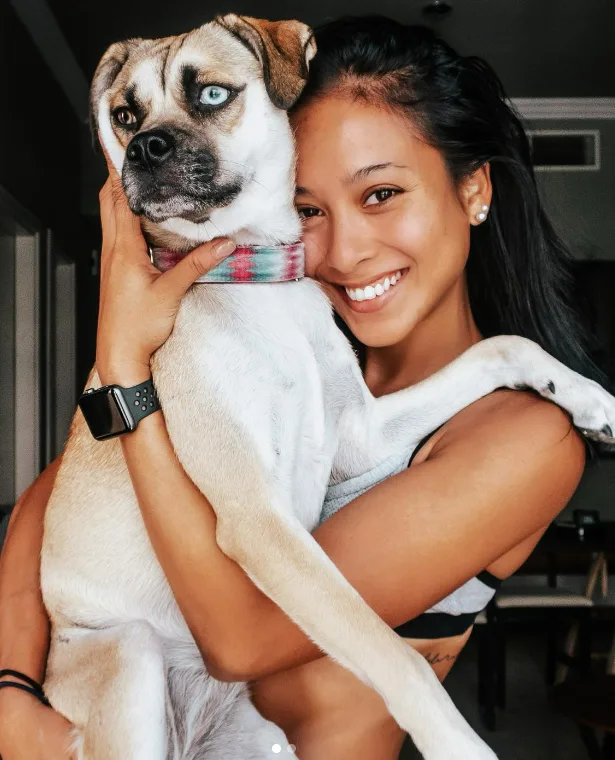
Husky Pug Mix Breeding
Although we can’t be sure when the first Husky Pug mixes were bred, the designer dog breed boomed in the last 20 years. It’s likely that the Husky mix with Pug was bred in the last 20 years or so.
It’s still a hot topic for debate whether or not crossbreeding is all that good. Many people argue that first-generation breeds tend to have more health issues and can have bad temperaments.
Whether or not you see this as a bad or good thing is up to you. But when looking to purchase any mix breed, you should always have proof from the breeder that the parents are in good health and were used to breed that particular litter.
4 Reasons to Avoid a Husky Pug Mix
There are reasons for getting a Hug dog, but there also reasons NOT to get a Hug! First, let’s take a quick look at 4 reasons why a Husky Pug mix may not be for you. All reasons will be covered in detail throughout the entire article.
- Prone to a lot of serious health issues
- Hard to train and can be significantly stubborn
- High maintenance breed that will require a lot of attention
- Intolerable of very hot, and very cold weather (Pug genes)
All of these points will be covered throughout this article in depth.
Check out the Husky Chihuahua Mix! (The most unique mix ever?)
4 Reasons Why You Should Get a Husky Pug Mix
If you’re really looking to get a Hug dog, you’ll also want to know their positives and why you should actually get one. Let’s take a look at 4 reasons why you SHOULD get this interesting crossbreed.
- Great family dogs and good with kids
- Very friendly and are rarely ever aggressive
- Can make great watchdogs for your family
- Are generally small dogs, not needing too much space or exercise (IF containing more pug genes)
This was just a quick snapshot of just a few of their positive traits which might make you want a Husky Pug mix.
Let’s take a look at the appearance and physical traits of the HUG dog.
⭐ Popular Article: Husky German Shepherd Mix (Gerberian Shepsky!)
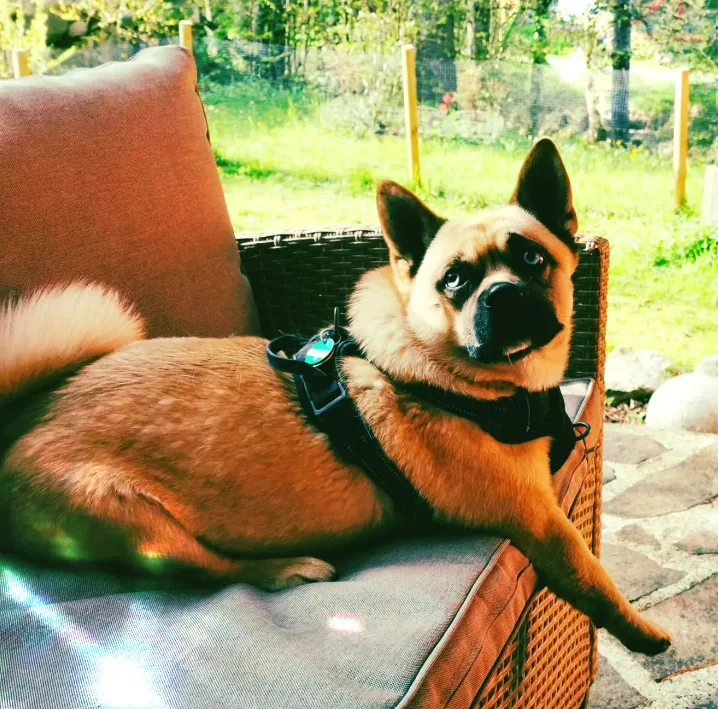
Husky Pug Mix Appearance and Physical Traits
This is where it gets interesting for the Husky Pug mix. The Husky and the Pug are two breeds that could not look more different even if they tried!
The best way to describe the Hug dog is almost like a mini-husky that has Pug features and shape!
Size & Height – How Big Does a Husky Pug Mix Get?
The Husky is a medium-sized dog whereas the Pug is a small-sized dog, what you end up with is a small-medium crossbreed that’s usually on the small side.
Many people ask how big does a husky pug get, and are interested in the full-grown size of the Hug dog. It’s a common question with a difficult answer… Due to the massive difference of size between each parent, it ultimately gives us a big range, and any crossbreed offspring could be as small as the Pug or as big as the Husky. Here’s the average height of a fully grown Husky Pug mix
- The average height of a fully grown Husky Pug mix ranges anywhere from 10 inches to 23 inches. This depends on which parent genes the crossbreed takes on more.
Weight
This is similar to height, as the two breeds are so drastically different. The weight ultimately depends on the size and height of the Husky Pug mix.
The average weight of a Husky Pug mix can range from as little as 15lbs all the way to 60lbs.
If you’re thinking about getting a Husky Pug mix puppy, try not to assume the mix will be a small dog, it could be in some very rare cases, just as big as a normal Husky!
Coat, Color, and Markings
Huskies have medium to long thick double-layered coats and contrary to belief the Pug also has a double-layered coat! Although their coat is short with a smooth glossy feel.
Their color and markings tend to stay separate. Huskies are typically white, gray, black or red with very bold markings, especially on their face, around their eyes, and head. Pugs are typically fawn color with a dark snout.
Husky Pug mixes will usually either be one or the other. Their colors and markings are usually either that of the pug parent or the husky parent. It’s rare to see a color/marking blend.
Nose and Snout
The snouts of each parent breed could not be more different. Huskies have a long prominent snout, and the Pug snout is pretty much non-existent. Husky Pug mixes typically have fairly short snouts that comes out just a little further than a Pug’s snout would.
Ears
Pugs tend to have small floppy ears whereas Huskies have large triangle standing ears. With Hugs, you can see a range of ear shapes.
An interesting observation, commonly seen with Husky Pug mixes is that when the coat color and markings of the Husky parent come through more, the ears tend to be floppy like the Pug. On the contrary, when the coat color and markings of the Pug come through, the ears tend to be standing upright triangles shape like Huskies. Pretty cool!
Eyes
One of the most visually striking parts of the Siberian Husky are their eyes. They have what’s called heterochromia, which is the condition causing them to have piercing blue/white eyes and sometimes a combination.
Husky Pug mixes have been seen to have the piercing blue eyes that the Husky can have. In even rarer cases, you will get a Hug puppy that has one brown and one blue eye.
Interesting related articles: Everything To Know About The RED HUSKY
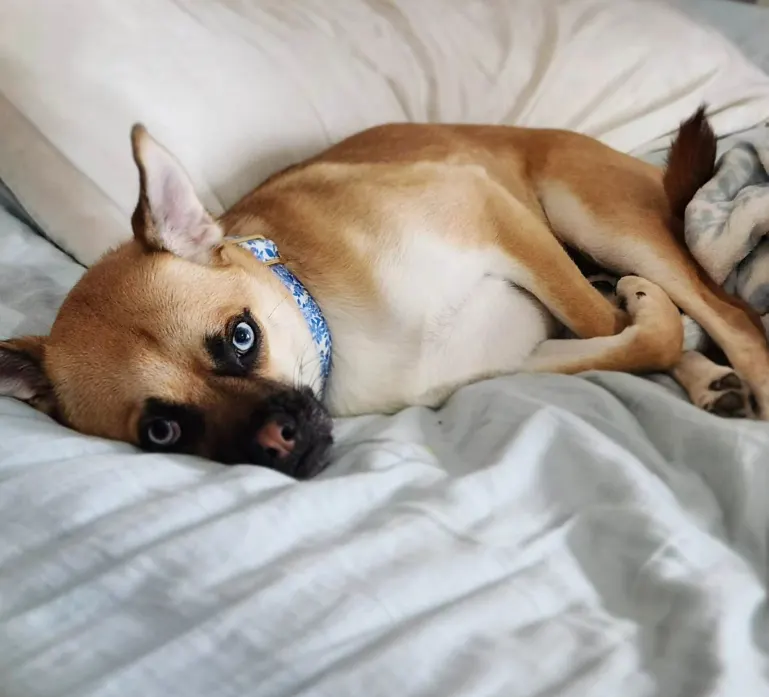
Husky Pug Mix Personality and Temperament
Let’s take an overlook at how we rate the personality and temperament of the Husky Pug mix.
It’s always important to remember that every dog will be different. What also has a big effect on temperament is what the parents were like. If one of the parents had any behavioral issues this could pass down to the offspring and cause them to show similar behavior.
We know that both the Siberian Husky and the Pug are both very friendly, loving and affectionate. So it’s very likely that your Husky Pug or “Hug” will be a great companion for you and your family.
Both breeds love attention. Huskies are considered by many to be the No.1 most attention-seeking breed there is. Pugs aren’t far behind too. The Hug will definitely want all the time they can possibly get from you and the family.
The Husky is very social and can easily make friends with other dogs or strangers without being aggressive or suspicious.
The Pug, on the other hand, needs strong socialization training in order to be like this. Pugs are not generally aggressive BUT they can be to unknown dogs or strangers. If you get a Husky Pug mix you’ll need to give them socialization training to be sure.
How Much Does a Husky Pug Mix Cost
The cost of the Husky Pug mix varies and can change depending on the breeder, the parents and of course your location.
So, how much does a Husky Pug mix Cost? The average cost of a Husky Pug mix puppy is $1200 – $2500
Top 20 Husky Mixes & How Much They Cost (Updated)
When on the search for a new puppy, it’s easy to get a little carried away and with too much excitement you can forget important checks you must do. Here are some of the basic things to look for when getting a new puppy:
- Use a trusted breeder that has references you can check on. If the breeder has been recommended by a veterinarian, this is the best.
- A good breeder will not pressure you into making any purchases. If the breeder seems too pushy for your money. This is not a good sign.
- Make sure the breeder has had the necessary healthy check-ups and test for the new puppy
- Proper certificates and health documentation should be present for the parents of the husky pug mix. If the parents are there, you should go and see them. Get a feel for their temperament and their general health and well-being. If something doesn’t seem right, look elsewhere
- Be very careful when looking online. Unfortunately, there are many illegitimate breeders using online websites to make a quick profit. Do the same checks as you would otherwise when looking in person.
Interesting article: Husky Pitbull Mix: The Pitsky Guide
Grooming Requirements of a Husky Pug Mix
Your Hug dog may have either inherited the Husky’s long hair, or the Pug’s short hair.
Either way, this won’t get you out of grooming. Grooming is an important part of keeping all dogs healthy and you will have to groom your Husky Pug mix frequently.
If your Hug inherits the shorter, smoother coat from the Pug parent, then you should brush them once or twice per week, which will remove any dead hairs that need to come out, as well as removing any dirt dust or hair tangles.
If your Hug inherits the longer hair similar to that of the Husky, then you’ll need to brush two to four times per week. The longer the hair, the more dead hair there will be in the undercoat.
Exercising a Husky mix with Pug
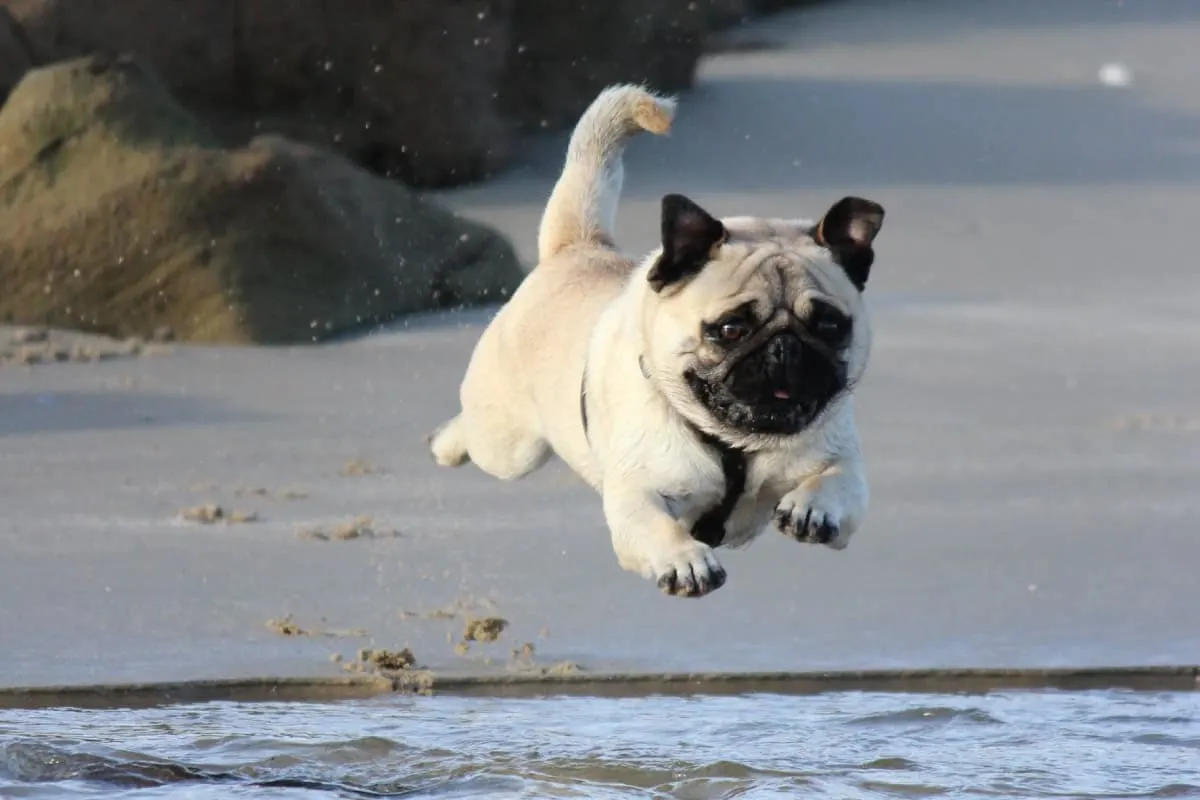
Huskies and Pugs are very different when it comes to their exercise requirements. The only way you will really know by monitoring your Hug as they grow up. If your Husky Pug mix seems like they have more Husky in them, they’ll need more exercise than if they’re genes are Pug dominant.
Siberian Huskies need around 2 hours of intense exercise per day. They have extremely high energy levels and they need to channel this through physical and mental exercise. When Huskies do not receive the exercise they need and desire, they tend to become very destructive and badly behaved.
Pugs are much smaller than Huskies, and despite having a lot of energy, they’re happy with a 30-40 minute walk per day. Most of the Pug’s exercise will come from playing and running around the house, which in most cases, they actually prefer.
As the parents are so different, the only way you will know how much exercise your Hug needs, is to monitor and gauge them as they grow. Eventually, you’ll be able to tell if they like longer, more intense walks, or if they prefer staying at home, chasing their ball.
Pug mix with Husky Diet Requirements
Siberian Huskies tend not to have big appetites and despite their size, are not greedy. When a Husky is feeling remotely full, they will leave their bowl even with food still in it.
Oftentimes, people consider Huskies to be very fussy eaters. In reality, I don’t think they are fussy eaters, I just think they leave food easily due to their naturally low appetite AND their sensitive stomach (which affects most Huskies).
Pugs, in general, are pretty normal eaters, they typically do not have issues eating, they can sometimes be fussy, or have sensitive stomachs, but usually, they have normal eating habits.
Here are some basic feeding tips for the Husky Pug mix:
- For puppies, 3 cups of high-quality dry kibble made for puppies
- For adults, 2 cups of high-quality dry kibble made for adult dogs
- It’s best to stick to a limited ingredient dog food made for sensitive stomachs
- Avoid the raw food diet (despite Huskies being able to eat this)
- Make sure treats do not amount to more than 10% of your Hugs daily food
- Stick to scheduled feeding times, do not free-feed or leave the bowl with food in it
- Always get advice from your veterinarian for the best diet
Husky mix with Pug Training Requirements
When it comes to intelligence, the Siberian Husky is officially considered of average intelligence, despite being trainable to a very high level.
Pugs are not as intelligent as the Husky, and some people even consider them to be a “dumb” breed. While they may not be as smart, many owners say that their Pugs are quick learners and can be very obedient once trained.
However, both breeds, especially the Siberian Husky have a stubborn streak in them, which means training can be very challenging. If your Husky Pug mix has more Husky genes, training will not be easy and you will be tested from day one!
Best practices for training a Husky Pug mix:
- Start the moment you bring them home
Many new owners make the mistake of letting their puppy run wild until they’re “old enough” to be trained. The truth is your puppy is ready to be trained instantly and should be to instill the correct behavior. The longer you wait, the harder it will be. - Establish the hierarchy
Both the Husky and Pug look to appease their owners, but you first must establish yourself as the leader, this will also help with all subsequent training. Remember that you are in charge and your puppy has to do things when you want them to. - All training should be Positive Reinforcement Based
The absolute best way to train all puppies is through positive reinforcement. Do not punish your puppy when they get it wrong, praise them when they get it right. Praise can be a small treat, or by making a big fuss out of them for a few seconds. Reward them the second they get any training correct. Your puppy will build the link between what’s asked and what they need to do very quickly. - Consistent training every day will be needed
Training should be done every day as much as possible. The more training you go through, even the basic commands, you’re Husky Pug mix will just learn to be more and more obedient. - Basic obedience commands should come first: Sit, Stay, Lay, Come Here, Paw
These are basic but very important. Once your puppy knows these commands, it makes more difficult training a lot easier and feasible. Considering this crossbreed mix will be difficult to train, it’s important you do this! - Recall and sociability training should start as soon as possible after basic commands.
With the Husky’s ability to be extremely stubborn, and the Pug’s tendency to be aloof. Recall and sociability training will be super important for a well-behaved crossbreed. Shift your focus to recall training and sociability after your Hug gets the basic commands.
If you’re interested in understanding more about training, I have a complete article covering all Husky puppy training. This will be just as useful for a Husky Pug puppy as well. It walks you through training, step by step.
Husky Pug Mix Health Issues
The Husky Pug mix has a lifespan of 12-15 years. Unfortunately, despite the generous lifespan, this crossbreed is prone to many health issues that can be difficult to fix.
The Husky is a generally healthy breed with typical health issues affecting most dog breeds. There are a few common problems that affect Huskies more and I will list them below.
Pugs, on the other hand, are known to have many health issues. Unfortunately, this breed is likely to suffer from many different problems throughout their life.
One illness effects Pug’s so much it’s even got their name in it. Pug Dog Encephalitis (PDE) is common amongst Pugs and is considered an aggressive and fatal inflammatory disease affecting the central nervous system.
Common health problems of the Husky mix with Pug include:
- Pug Dog Encephalitis (PDE)
- Hip & Elbow Dysplasia
- Brachycephalic Airway Obstruction Syndrome (BAOS)
- Cataracts
- Progressive Retinal Atrophy
- Dermatitis and Skin Issues
- Follicular Dysplasia
- Zinc Deficiency
- Hypothyroidism
There are more issues, but these are the most common affecting both parent breeds.
It’s very difficult to avoid health issues in dogs but at the very least you can ensure you are giving your dog a healthy active lifestyle, and supplement this with regular check-ups at the vet to assess their health. It may be costly, but the health of your fluffy friend is invaluable.
Origins of the Pug
The Pug is believed to have got their name from the lain word “fist” because their face & head looks like a fist!
The popularity of Pugs has dramatically boomed in the last several years and is now a very popular household pet. But the Pug has a lot of deep history that many people may not be aware of.
Pugs originated back during the Han Dynasty in China (206 B.C – 200 A.C) and typically lived very luxurious lives. Pugs were loved by emperors and sometimes even had their own guards!
Many historians and researches believe that Pugs are related to the Tibetan Mastiff. What we do know is that Pugs are one of three types of short-nosed breeds, the Lo-Sze (considered the ancient pug), the Pekingese and the Lion Dog.
Eventually, during the 1500s, China started trading with Europe and this is when Pugs made their first appearances in European Countries, thought to have been brought by Dutch traders. It didn’t take long before Pugs became a loved dog by many royal families across the whole of Europe, in the latter years, even Queen Victoria owned several Pugs, and bred them!
It took a little longer for the Pug to reach the United States, but they eventually made it after the Civil War. In 1885 the breed was recognized by the American Kennel Club.
Origins of the Siberian Husky
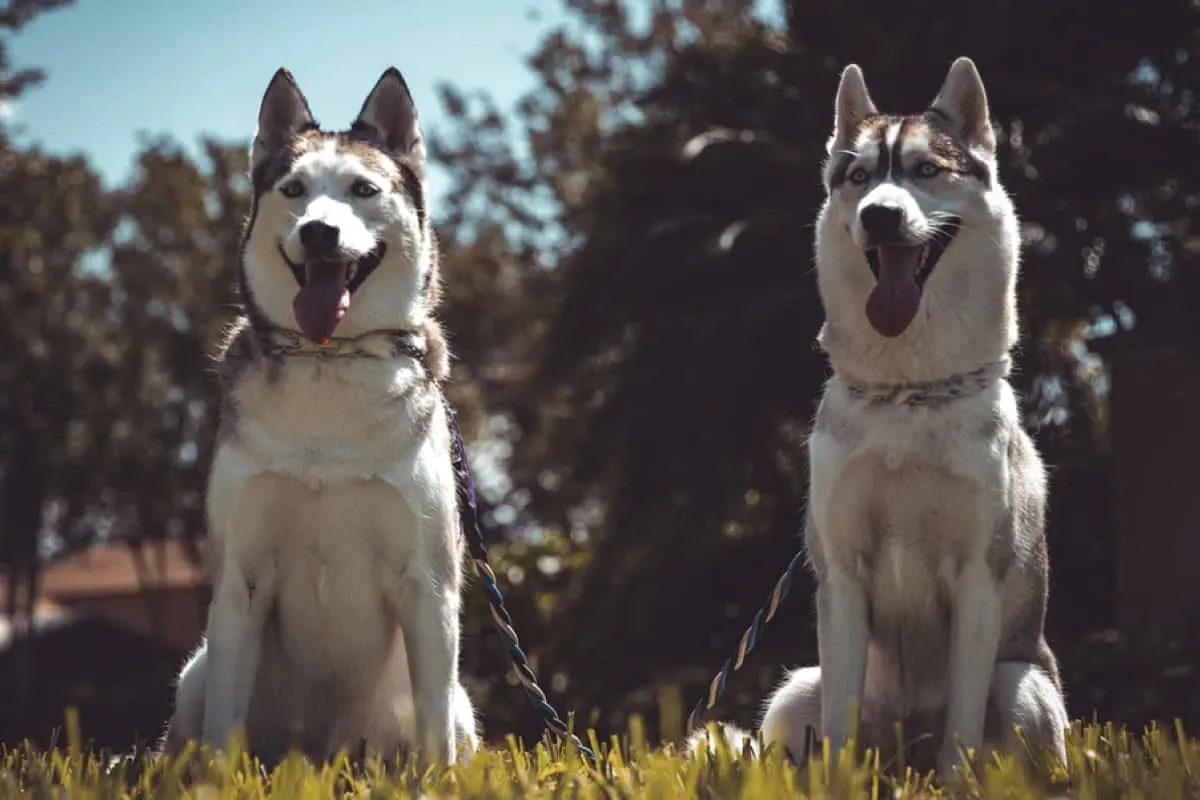
The Siberian Husky also have their fair share of history and are actually one of the oldest breeds of dog in the world.
Siberian Huskies were bred thousands of years ago by a nomadic group of people known as the Chukchi Tribe. This tribe came from Eastern Siberia and lived a nomadic, hunter-gatherer type lifestyle, constantly migrating and never settling in one place for too long.
The Chukchi Tribe couldn’t have lived this life without the help of the Siberian Husky. Huskies were used to pull heavy sleds of goods across vast distances in arctic conditions. On top of this, they helped the tribe hunt and was their mode of transport.
After living this way for so long, Siberian Huskies became one of the most resilient breeds we know, with super high energy levels, work drive, and extreme tolerances of cold conditions. One thing significant about the Chukchi’s is that they treated their dog companions extremely well, sharing their food and tents. This is believed to be why Huskies are extremely social, friendly and affectionate.
Siberian Huskies made it to Alaska during the Gold Rush and were utilized for pulling heavy sleds. Soon after this, they were exported to the USA in 1908 to take part in the All Alaska Sweepstakes for 1909. It was reported that the pack of Siberian Huskies was actually winning this very famous race, but the leader was bribed to let two local teams pass and win, to stop the major controversy.
Summary
The Husky Pug mix is one of the most popular of the Husky mixes, and it is a very interesting mix.
With this Hug dog, you’ll have a loving family dog that will be excellent with children. You’ll a great companion for many years to come.
If you particularly want a breed that can be easily trained or does not suffer from many health issues, then this mix may not be for you.
Thank you for reading, I hope this has been a resource that has helped you better understand the Husky Pug Mix or HUG dog 🙂
Other Husky Mixes to checkout:
Husky Akita Mix
Husky Australian Shepherd Mix
Husky Rottweiler Mix
Husky Chow Chow Mix
Most Recommended For Huskies 🐶
Best Brushes For Husky Shedding ⭐
My two favorite brushes for a beautiful coat are a simple Undercoat Rake and a Slicker Brush. These brushes when used together will de-shed and maintain your husky’s coat better than anything else.
Best Online Training Program For Huskies⭐
Brain Training For Dogs has become increasingly popular with Siberian Huskies in the last few years. It’s now recognized as perhaps the best way to train a husky in the most stress-free, positive way.
Best Husky Puppy Book ⭐
If you would like to support My Happy Husky directly and have an easy to read and entertaining guide for training your husky puppy, check out my book The Husky Puppy Handbook on Amazon. All purchases are greatly appreciated.
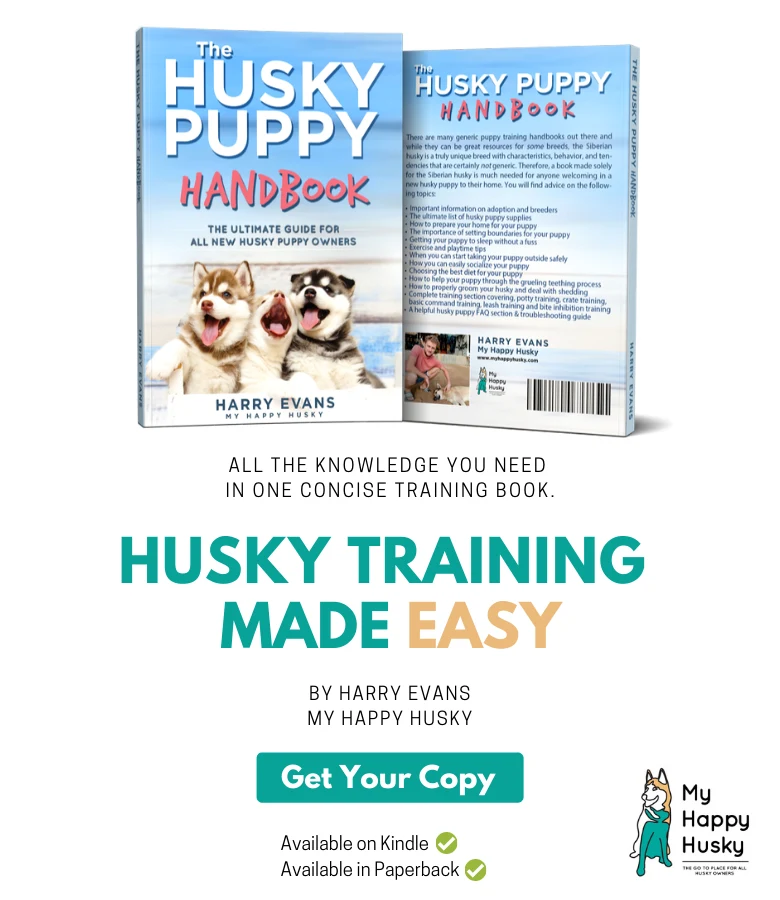
Other Resources:
https://www.ncbi.nlm.nih.gov/pmc/articles/PMC1790528/
https://www.ncbi.nlm.nih.gov/pmc/articles/PMC4903005/
Disclaimer
The advice given in this article is for educational purposes only and does not constitute professional advice in any context. Before making any decisions that may affect the health and/or safety of your dog, you should always consult a trained veterinarian in your local area. For the FULL disclaimer Visit HereCopyright Notice: The content produced and published on My Happy Husky is unique and original. My Happy Husky makes an active effort to search for plagiarized content using plagiarism detection software. If plagiarized content is found, action will be taken.
